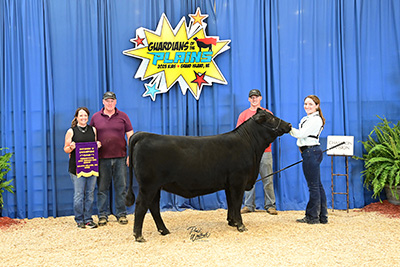A Proven Performance Program
Breeding Angus Cattle for Over 45 Years, 4 Generations

Alexandra, Lori, Lee, Ashley and Andrew

History of Grassy Valley
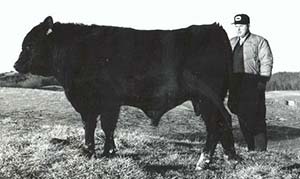
Ducky and Emulous Pinpointer 7000 - 1975
Unknown to him at that time the beginning of Grassy Valley
Angus traces its roots to rural Union County Georgia around
1918 when young Ancel Duckworth began to take on responsibility
for the care of the family cattle. As was the tradition at
the time, the cattle ran loose in the mountains searching for
pasture and young Ancel’s job was to ride out to check them
using the bells tied around their necks as the only aid in locating
the herd. The family relied on cattle for milk, food, and
labor as they worked yoked oxen in their fields. From these beginning, Ancel developed a life long
passion for cattle and
livestock industry. That passion drove him to attend The
University of Georgia where he graduated with a Doctor of
Veterinary Medicine degree in 1929. Ancel was originally employed
by the State of Georgia, but he was looking for something
more. He had heard about Greene County in Tennessee
where there were large numbers of dairy and beef cattle and
he decided to go visit the area and take a look. Following
a few visits he decided to move his young family to Tennessee
in 1933 and established his
practice in an
extra room at
the Greeneville
Livestock Market
becoming
the first licensed
Veterinarian in
Greene County.
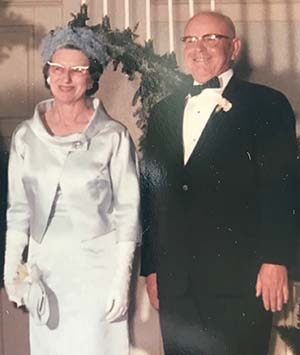
Dr. Ancel and Sara Duckworth
He worked with
local farmers
extensively on
dairy and beef
cattle as well as a
large number of
hogs. His practice
and his family
grew and he
moved his office
a couple of times before building a permanent location just off North Main Street. Following World
War 11 he was able to
purchase a small farm of his own.Shortly after that purchase
he traded that small farm for a larger one across the road in
partnership with his younger brother Jack. In 1959 Ancel’s
son “Ducky”, A. L. Duckworth Jr., graduated from Auburn University College of Veterinary
Medicine
and returned home to
practice. Ducky bought Jack’s interest in the farm and with
Ancel’s help began buying some commercial cows for their
operation. Over time they noticed that their Angus cows just
did a little better than the others and they became hooked on
Angus. Their ideas for improvement differed with Ducky believing
a quality bull had the greatest genetic impact on the
herd and provided the fastest road to improvement.
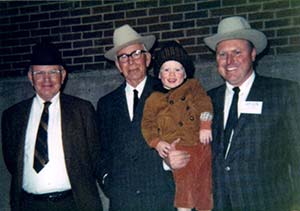
Ancel, Frank (Big Daddy), Lee, and
Ducky Duckworth - 1968
At this
time, without any performance measures or selection tools,
the prevailing logic of the day favored extremely moderate
“baby beef” type animals. Ducky purchased some of these
bulls from a nationally prominent herd in the area and they
were introduced to the cow herd. Ancel and Ducky were
very active in the local feeder calf sales and marketed their
calves through those sales. Realizing they sold cattle by the
pound they realized that there had to be a better way because
their “baby beef” sires were not adding any pounds and
their calves were just too small. Ducky understood genetics
and understood that yearling weight was the most heritable
performance trait. He had been reading about some higher
growth, feed efficiency tested Angus bulls in Kansas and decided
to go take a look. Liking the larger higher performing
Emulous cattle he purchased three bulls and brought them
back to Tennessee. He often remarked that those bulls had
added 50 pounds per calf at the feeder sale the next year and
that he could understand that difference real well. They were
hooked on performance cattle from that moment on.
In the fall of 1966 Ducky purchased his first registered Angus
cows from Jerry Morrell who was managing Steadman
Farms at the time. Over the years the number of registered
cows continued to grow as daughters were retained in the
herd and the commercial Angus cows were gradually eliminated.
Ancel was extremely proud of his registered cows and
understood the value of pure documented genetics, often remarking
that cross bred cattle were unpredictable mongrels.
Over this same time period additional land was purchased
and the number of cows was able to increase.
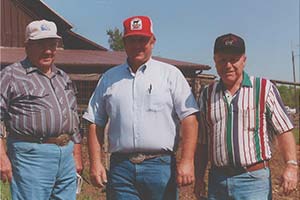
Ralph Bridges, Harvey Lemmon, and
Ducky - First Sale 1994
Through the
mid to later 1970’s the pendulum of popular Angus genetics
swung to the opposite extreme favoring very tall and often
not too thick cattle. Without any EPD’s or selection indexes of
any type some of these genetics were incorporated into the
herd though artificial insemination especially after the introtroduction of lutalyse and the
ability to synchronize heats for
breeding. These taller, thinner
cattle were very unproductive
in our environment and quicky
they realized that something
had to change. At this time a lot
of things were changing in the
Angus world. The widespread
use of computer technology
had allowed the development
of Estimated Breeding Values
followed quickly by the first
Expected Progeny Differences.
The need for change fueled the
early use of these technologies
and the livestock industry was
changed forever. These new
technologies were incorporated into the herd as birth, weaning
and yearling weights were now taken and submitted by
mail to the Angus Association for incorporation into the data
base and the old, but very practical, method of comparing average
feeder sale day weight was abandoned.
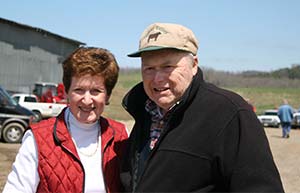
Dr. A.L. (Ducky) and Nancy Duckworth
In 1992 Lee Duckworth graduated from the University of Tennessee College of Veterinary Medicine and returned home to practice. He began to gradually take over the day to day operation of the farm and continued to incorporate each new technology for evaluating all aspects of beef cattle performance. Birth weights, weaning weights, yearling weight, ultrasound carcass evaluation, heat synchronization technologies for artificial insemination, embryo transfer, genomic testing, and Maternal Plus whole herd evaluation are just a part of daily life these days. Just as Grassy Valley began as a commercial operation, cattle are still selected to perform in our practical environment so they will perform for commercial cattlemen in the southeast.
In 1994, at the urging of Tom Burke, the first production sale
was held featuring both bulls and females. During the 90’s
marketing Angus bulls was a much more difficult proposition,
but Tom insisted remarking “No business can survive marketing only half of what it
produces.” He was correct and
the commitment to the production
of high quality Angus
bulls that meet the needs of
commercial cattlemen was solidified.
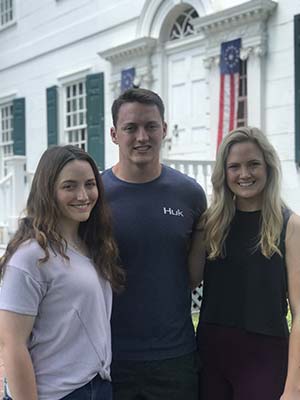
Alexandra, Andrew, and Ashley Duckworth
The Annual Production
Sale has continued over the
years as each new technology
was embraced to better evaluate
our product and determine
its true genetic merit. After all
our job is to use all available
resources to most accurately
characterize the genetic merit
of each animal so that the buyer
knows how to use them.
Ancel passed away unexpectedly in 1981 but was blessed to spend the last evening of his life driving through the pastures looking at the cows that he loved. Ducky passed away in 2016 after battling dementia for many years. Ducky had instilled the value of unbiased performance measurements and evaluation upon all of us, there were no short cuts to success in his book, but success was attainable by everyone who dared to do the work, and endure the challenges that were certain to come while still holding to the values of character and integrity he held so dearly.
Today as the fourth generation in Ashley, Andrew, and Alexandra enter adulthood the mission remains unchanged in that we expect the next generation to be better than the last. The process continues on the farm as we quietly go about our business objectively characterizing the genetic merit of our product in order to best predict its future performance. What had begun, a little over 100 years ago, as Ancels’s dream to have a few cows of his own, has grown literally one piece at a time into 377 females as we prepare for our 30th Production Sale.


